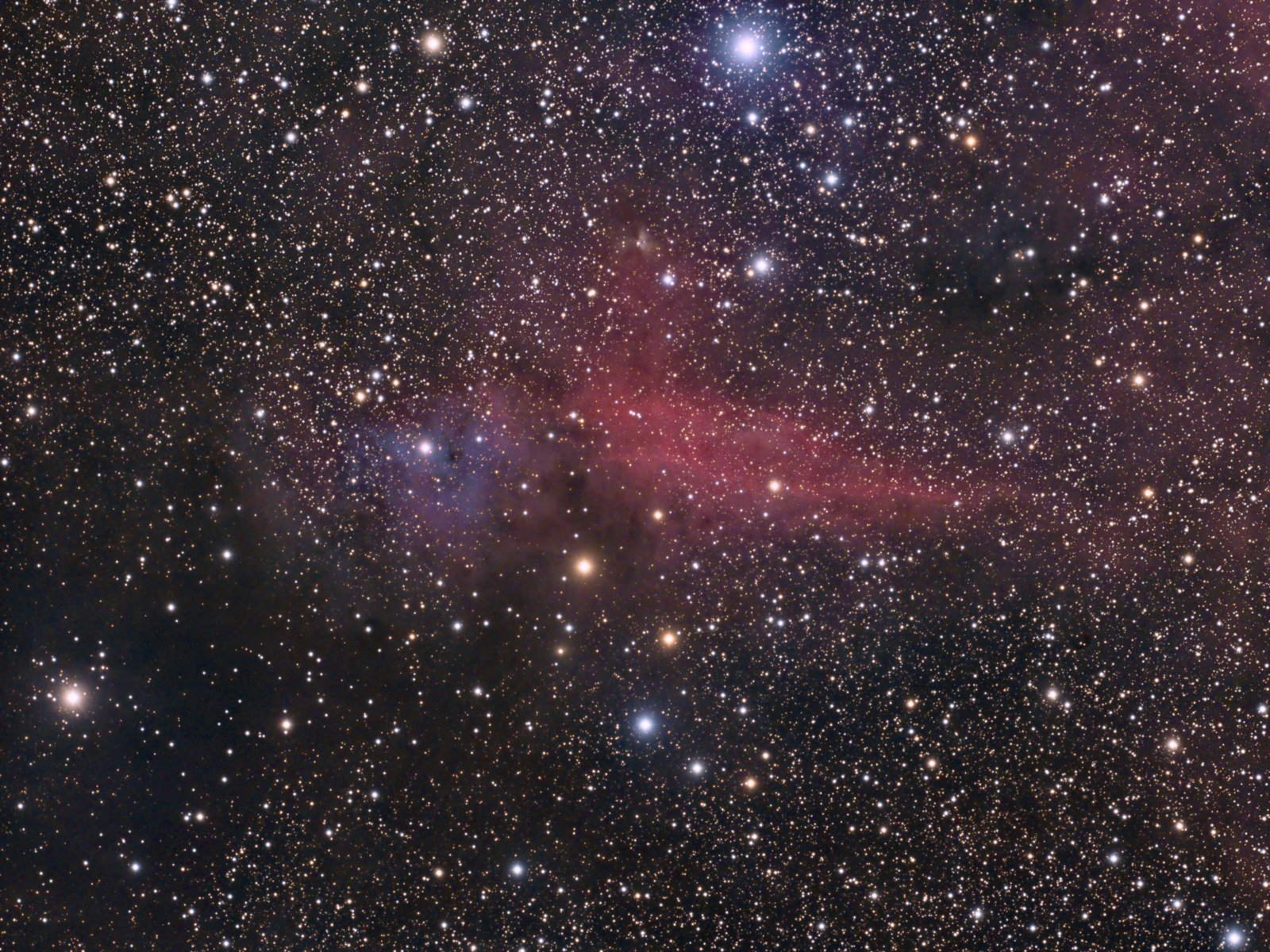Sh2-150 and vdB-154
 Click image for full size version
Click image for full size version
September 29, 2020
This image shows Sh2-150, the red object towards the right side of the image, and vdB-154, the blue object towards the left. The abbreviation “vdB” refers to the van den Bergh catalogue of reflection nebulae. Sh2-150 lies about 2900 light years away in the constellation Cepheus. I am not sure whether vdB-154 lies at the same distance, because there was very little information available about either object.
There is also a straw-coloured, fan-shaped reflection nebula in the red glow above centre. I learned from my reddit-friend ‘spastrophoto’ that it carries the designation RNO142. The RNO catalog is a list of 170 Red and Nebulous Objects in Dark Clouds compiled in 1980 by Martin Cohen and published in the Astronomical Journal. Emission nebulae glow red due to energy released from excited hydrogen atoms. The energy is absorbed as infrared light from nearby stars. Reflection nebula don’t emit light. As their name suggests, they reflect the light of stars near them, and tend to be blue or yellow. In this case the red of Sh2-150 and the blue of vdB-154 impart a purplish hue to the left-central region of the image. Scattered throughout the image are several areas that are relatively free of stars. These soot and dust in these dark nebulae block out the light of stars behind them.
Tekkies:
Acquisition, focusing, and control of Paramount MX mount, unguided, with TheSkyX. Focus with Optec DirectSync motor and controller. Automation with CCDCommander. Equipment control with PrimaLuce Labs Eagle 3 Pro computer. All pre-processing and processing in PixInsight. Acquired from my SkyShed in Guelph. Average transparency and seeing. Data acquired August 14-31, 2020 in a mostly moonless sky.
Luminance and Hydrogen alpha: Sky-Watcher Esprit 150 f/7 refractor and QHY 16200-A camera with Optolong UV/IR and H-alpha filter
Chrominance: Takahashi FSQ-106 ED IV @ f/5 and QHY367C Pro one-shot colour camera with Optolong UV/IR filter
Chrominance: 235 x 5m = 19hr35m
Total: 41hr25m
Data Reduction and Initial Processing
Preprocessing: The WeightedBatchPreProcessing script was used to create Luminance and H-alpha master frames (from the mono camera) and a RGB master frame (from the one-shot colour camera).
Gradient Removal: DBE was applied to Luminance, H-alpha and RGB masters using Subtraction.
Colour
Colour Balancing: Colour of the RGB master was balanced with PhotometricColorCalibration.
Linear Noise Reduction: MultiscaleLinearTransform was used to reduce noise in the background areas, using an internal mask to protect bright structures. Layer settings for threshold, strength and iterations were as follows: Layer 1: 5.0 0.85, 1 iteration; Layer 2: 3.5 0.75, 1 iteration, Layer 3: 2.0, 0.5, 1 iteration.
Stretching: HistogramTransformation was applied to make a pleasing, bright image, with background set to an intensity of approximately 0.10.
Luminance
Deconvolution: A star mask was made from the Luminance master to use as a Local Deringing Support Image. A copy of the image was stretched to use as a range mask. Deconvolution was applied (100 iterations, regularized Richardson-Lucy, external PSF made using the PSFImage script; Global dark deringing = 0.03).
Linear Noise Reduction: MultiscaleLinearTransform was used to reduce noise in the background areas of the Luminance-filtered image, using an internal mask to protect bright stars. Layer settings for threshold, strength and iterations: Layer 1: 5.0 0.85, 2 iteration; Layer 2: 3.0, 0.75, 1 iteration; Layer 3: 1.5, 0.25, 1 iteration.
Stretching: HistogramTransformation was applied to make a pleasing, bright image, with background set to an intensity of approximately 0.10.
H-alpha
Deconvolution: A star mask was made from the H-alpha master to use as a Local Deringing Support Image. A copy of the image was stretched to use as a range mask. Deconvolution was applied (80 iterations, regularized Richardson-Lucy, external PSF made using the PSFImage script; Global dark deringing = 0.02).
Linear Noise Reduction: MultiscaleLinearTransform was used to reduce noise in the background areas of the H-alpha image. Layer settings for threshold, strength and iterations: Layer 1: 3.0 0.85, 1 iteration; Layer 2: 2.0, 0.75, 1 iteration; Layer 3: 1.0, 0.25, 1 iteration.
Stretching: HistogramTransformation was applied to the Ha to make a pleasing, bright image, with background set to an intensity of approximately 0.10.
Combining Luminance, Colour and H-Alpha Images
Make LRGB: The Luminance was applied to the RGB image using LRGBCombination with default settings.
Make HaLRGB: PixelMath was used to add Ha to the LRGB image, using the following expressions for the R, G and B channels:
R: max($T[0], 1.1*Ha)
G: $T[1]
B: iif($T[0]<Ha, $T[2] + 0.08*Ha, $T[2])
Additional Processing
Nonlinear Noise Reduction: TGVDenoise was used in L*a*b* mode to reduce noise with a mask used to target the background areas and protect the stars and nebula (max. 1,000 iterations and convergence selected for both lightness and chrominance).
Contrast Enhancement: LocalHistogramEqualization was applied with a scale of 50 (max contrast 1.5, strength 0.35, 1 iteration), followed by a scale of 150 (max contrast 1.5, strength 0.25, 1 iteration).
Sharpening: MultiscaleLinearTransform was used to sharpen Layers 2 and 3 with strengths of 0.1 and 0.08, respectively. A mask was used to select only bright nebular features for sharpening.
Final Steps: Background, nebula and star brightness, contrast, and colour saturation were adjusted in several iterations using CurvesTransformation with masks as required. The DarkStructureEnhance script was run with 0.2 for the Amount. ICCProfileTransformation (sRGB IEC61966-2.1; Relative Colorimetric with black point compensation) was applied prior to saving in jpg format.






Very beautiful thanks for sharing you processing information this really helps